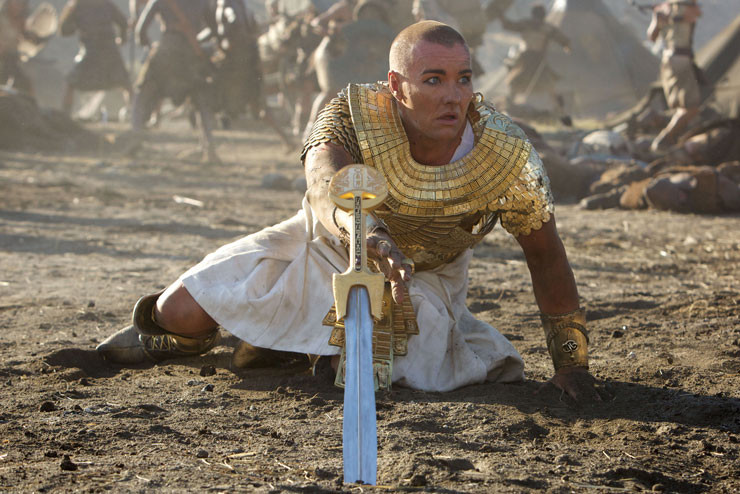Brandon Sanderson was never supposed to write a Mistborn series set in “the Old West.”
The story that became the novel The Alloy of Law was originally a writing exercise, a way for Sanderson to stretch his muscles before diving into the complex and senses-shattering work of finishing A Memory of Light and with it, the entire Wheel of Time series. Sanderson certainly meant (and still means) to write another Mistborn series, but in a 1980s-style setting, examining how Allomancy, Feruchemy, and Hemalurgy would affect the technology of that period. (Allomantic Steve Jobs and Bill Gates would have the weirdest fights!)
But Wax and Wayne, once created, could not be denied, and in the next four months we will read two new Mistborn books—Shadows of Self and The Bands of Mourning—that further explore these two characters and the western frontier era of their Cosmere world, Scadrial.
This quick road trip through the Old West has been pretty fruitful, all told (railroads…gunfights…fancy hats…who could resist, really?) And this got me thinking: What other periods or settings in history would it be cool to see a Mistborn story unfold in?
The End of the Bronze Age (Circa 1200 BCE)

The growth of early human civilization in the Mediterranean area, North Africa, and the Middle East is categorized into its own trilogy: The Stone Age, the Bronze Age, and the Iron Age. These ages differ from region to region, but all three of the above-mentioned regions suffered through a stunning civilizational collapse that marks a common end to the Bronze Age for all of them. Egypt, Greece, Mesopotamia…to this day, the sudden folding of one empire after another remains a much-studied mystery.
This would be an incredible age in which to depict Allomancers and their various feats. Even in decline, the kingdoms of Egypt, Babylon, and Troy were fertile ground for epic stories, even today, and looking at this kind of environment through the lens of Allomancy would bring some interesting twists to this slice of human history. In this age, civilizations tended to depict their rulers as vessels of the gods. Suppose these leaders were actually Mistings, who could back up their claims of having been chosen, or of having rapport with the gods with actual “magic”!
Mistings would be a treasured level in Ancient Egypt’s class system as a result, and the desire to be a part of that level of society would spur on experimentation with metals, giving Mistborn readers a glimpse into how the Allomantic table of metals was constructed. While a reader would have that information, a Mistborn would have to puzzle it out piece by piece. Even then, they’d only be able to use certain powers since only some metals would be available to them. Of the metals that enhance physical powers, Mistborn could only burn tin and pewter. They would have access to all four of the metals that enhance mental powers–zinc, brass, copper, and bronze–but their Zinc Rioting would be weak and sickly, as zinc wasn’t customarily purified until after the Bronze Age.
Interestingly, Mistborn would have access to half of the Temporal metals, as gold and electrum were available during this period. Electrum Mistings would be powerful members of society indeed, as all of their predictions of the future would come true! The Greek Oracle at Delphi is only two hundreds years old at this point in time, too. Coincidence? (Yes. But a really snazzy one.)
A small note: China had access to chromium at this time, but the rest of the Ancient World did not, which would leave the various territories in China with the only Mistings capable of negating any other kingdoms’ Mistings. That’s one hell of a tactical advantage.
Perhaps that’s why the ancient civilizations of the Bronze Age came to such a sudden collapse. Or maybe it all comes down to a clever Mistborn in Anatolia (today known as eastern Turkey) figuring out how to use iron to their advantage, beginning a brand new Age for humanity….
Muhammad Becomes the Last Prophet (610 CE)

One fateful day in the year 610, the 40-year old Muhammad entered the Cave of Hira and there, according to Islamic tradition, was visited by the archangel Gabriel and received his first divine revelation; these revelations would continue for the rest of his life. Three years after his experience in the cave, it became clear to Muhammad that he was, in fact, the last of a long line of Prophets that included Adam, Abraham, Moses, Jesus, and more, and that he was to bring these revelations to humanity.
Two decades followed, with Muhammad teaching his disciples that surrender to God—the very meaning of “islam”—is the only true way to live according to these revelations. These teachings did not come easily to the tribes who existed in present-day Saudi Arabia and the Arabian peninsula at large. Muhammad and his followers were hunted, chased from village to village as their congregation grew. Muhammad eventually led a group of Muslims 10,000 strong against Mecca, the city of his birth, which had until that moment barred its doors to him.
Muhammad himself died 22 years after his vision in the Cave of Hira, having converted the majority of the Arabian Peninsula to Islam. Interestingly, God’s revelations to Muhammad were never compiled during the Prophet’s lifetime. The book of these revelations, known as the Qur’an, was only assembled by his scribes and companions after Muhammad’s death.
Or perhaps, in a different world and time, it might simply take that long for someone to find the metalmind where a prophet had stored divine revelations.
Just to be clear, I’m not advocating rewriting the origins of Islam to include elements from the Mistborn series, but rather using the story as a point of inspiration—imagining how the mere discovery of the magic of Feruchemy would have an enormous impact on the progression of humanity if revealed in a manner as specific and mystical as Muhammad’s trip to the Cave of Hira.
Imagine a similar figure struggling during a period of scarcity in Scadrial’s past. He or she is no Allomancer, but what good are Allomancers when all around is sand and sun-baked stone? This figure takes shelter in a nearby cave to rest and consider the best direction for their family and for the other people who live in the nearby town of Terris.
Today, however, the cave is different. Someone has been here, and in the spot where this figure usually sits to contemplate are two objects: a bead of metal, and a copper band. Without knowing why, the figure feels compelled to ingest the Adonalsium bead of as-yet-unknown-metal and put on the copper band. The moment is small but the consequences will reverberate throughout the rest of Scadrian history: The first Feruchemist has been created, and now we will see how the actions and words of one individual can change the course of nations, and reverberate for millennia afterwards….
The Catholic Church Makes Torture a Law (1252 CE)
 The history of Europe in the Middle Ages is constantly influenced by the actions of the Catholic Church, for good and for ill. During the 12th and 13th centuries, the Church faced a variety of challenges to its dominance, from internal power struggles over who should be Pope, to external land-grabs by nobility and neighboring kingdoms. The leadership of the Church during this time was often tempestuous, which is as close as I feel like getting to justifying the actions of Pope Innocent IV (I know, right?) in 1252, when he decreed the Ad extirpanda, a papal bull that demanded the torture of heretics.
The history of Europe in the Middle Ages is constantly influenced by the actions of the Catholic Church, for good and for ill. During the 12th and 13th centuries, the Church faced a variety of challenges to its dominance, from internal power struggles over who should be Pope, to external land-grabs by nobility and neighboring kingdoms. The leadership of the Church during this time was often tempestuous, which is as close as I feel like getting to justifying the actions of Pope Innocent IV (I know, right?) in 1252, when he decreed the Ad extirpanda, a papal bull that demanded the torture of heretics.
This Church law stood for over three hundred years and allowed for the torture of thousands, if not millions, of people. One of devices used for confessional torture was the “Iron Chair,” a chair covered in small spikes that a person was then pushed into by a series of straps. (Pictured here.) If the torturer didn’t like your answer to their question, the straps were tightened, and you were sunk further into the beds of spikes.
This seems like a very likely origin story for the discovery of Hemalurgy, the magic that allows the theft of Allomantic and Feruchemical abilities from Mistings and Feruchemists via Big F’ing Spikes. (And the primary Hemalurgists in the series are called Steel Inquisitors, after all.) All it would take is one Iron Chair actually made of iron to sink its spikes into an Iron Misting. If the chair was used immediately afterwards (which seems likely), the next person tortured would suddenly gain the strength of the previous Misting, allowing them to break free of the chair itself! That person would immediately lose the strength as soon as they stood up, but the mysterious behavior in itself would undoubtedly prompt the inquisitors to investigate the strange occurrence, especially if it repeated.
A Church with knowledge of Allomancy and Feruchemy would figure out what happened pretty quickly, expanding on the study of this new “magic,” making extremely powerful enforcers in the form of Steel Inquisitors, and granting other abilities to nobles and royals which they favor, or for whom they wish to create a debt. For all we know, this could be the same Church founded by the First Feruchemist, twisted over the centuries into something selfish and evil. Would the discovery of Hemalurgy eventually lead to the Church’s reform? Or its downfall? Or would it expand to rule the entirety of Scadrial?
10,000 Samurai Summon a Typhoon (1281 CE)

The invading force of Yuan Dynasty Chinese Mongols was 140,000 strong. The Kamakura Shogunate, exhausted from infighting, previous attacks from the Mongols, and battles with other Shogunates, could only summon 10,000 samurai to defend the coasts of Japan. The samurai could match the ferocity of the Mongols, but not their numbers. Perhaps it should not have executed every peaceful ambassador that the Mongols had sent in the previous years? The Shogunate, it seemed, would fall to the invaders.
Unless a typhoon swept in to wipe out the majority of the invaders as they crossed the Sea of Japan. A hurricane so fortuitous it appeared as if summoned. When the storm subsided, the samurai stood victorious at the water’s edge, their folded armor drenched in the waters of the heavens and the blood of their enemies.
Now add Allomantic abilities to a battle this epic. Both the Mongols and the samurai would have access to all but five allomantic metals, as well (cadmium, bendalloy, nicrosil, aluminum, and duralumin), allowing for intense, picturesque battles. Further, this moment in history would be a great way to see how an entire army would utilize Allomancy en masse, as opposed to a handful of Mistborns.
Man Lands on the Moon (1967-1969)

Only twenty years prior to Space Race, the U.S. threw everything into the development for the atomic bomb and its victory in that race ensured the end of World War II. Now Russia was reaching beyond Earth itself—having been the first nation to put a man in space, they were now intent on being the first to put someone on the moon. The U.S. government knew it had to get there first.
It would be fascinating to see Allomantic, Feruchemical, and maybe even Hemalurgic abilities put to use during these short, tense years of the Space Race. NASA would have access to the full allomantic chart of metals, and would undoubtedly combine their effects with “normal” technology in ways both simple and ingenious. This fierce welding between conventional technology and magic would be fascinating to read about, especially when every small advance would have such huge political implications for the world beyond. We have never seen nations compete against each other on Scadrial—how would that competition drive technological and allomantic innovation?
Of all the scenarios listed in this article, I feel like we actually have a chance at seeing this one play out in a future Mistborn novel. Brandon Sanderson has stated that after the “1980s tech” trilogy, he’s going to focus on a series that involves Scadrians figuring out how to travel out into space. A prologue chapter covering the origins of Scadrial’s space race, if it has one, wouldn’t be out of place in this latter trilogy.
These are only a handful of contexts that it would be cool to see Mistborn powers at work in. What else might there be?
Chris Lough would like to know if there’s such a thing as a Lego Misting because he suspects he ate a lot of them as a child and now he’s kind of off.









